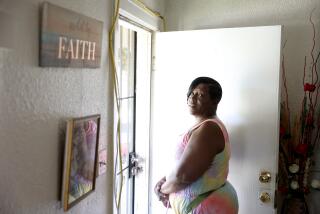System Fails to Protect Teen-Age Runaways, Coalition Charges : Youth: Report says a $46-million program to provide services will save state tens of millions of dollars by diverting young people from crime.
The thousands of teen-age runaways who flock to Los Angeles each year are among the most desperate and vulnerable members of society, and the state has failed in its responsibility to protect them, according to a report Tuesday by a coalition of state and private social service workers.
The California Child, Youth and Family Coalition also proposed a comprehensive policy to direct the stateâs response to the growing number of runaways in need of shelter, medical attention, job training and other services.
The nonprofit coalition developed its report in collaboration with representatives of 30 state and private social service agencies over the past six months, many of which work with runaways in Hollywood.
Implementing the policy would cost $46 million a year, mostly for shelter beds and transitional living programs, said coalition chairman Gary Yates. But its savings in human misery and in diverting youths from lives of crime and incarceration would save the state tens of millions of dollars annually, said Yates, associate director of adolescent medicine at Childrens Hospital of Los Angeles.
âIt is time for the state to meet its obligation to these troubled youth and to live up to the often stated sentiment that âchildren are our most precious resource,â â the report said. A star witness at the Hollywood news conference at which the report was presented was Jasen Marsh, a 17-year-old runaway who has been living on the streets and in the shelters of Hollywood for three years. Confirming findings by state officials, he said runaway youths are getting sick, being beaten up and driven to despair, prostitution, drugs and alcohol--and that the situation is worsening.
âWe definitely need more help,â said Marsh. âThere are a lot of people out there who are deathly ill. . . . Theyâre my friends.â
Runaways are drawn to Los Angeles--and Hollywood in particular--for a variety of reasons: a need to escape an unhappy home life; a quest for fame, fortune and sunshine.
Officials estimate there are 42,000 runaways between the ages of 10 and 17 needing shelter in California, and at least an equal number of young adults under 21 living on the streets. More than 10,000 teen-age runaways can be found on the streets of Los Angeles on any given day, with more than 1,000 living as squatters in abandoned buildings and makeshift shelters in Hollywood alone, officials said.
Although there are 700 shelter beds throughout the state, at least 2,000 more are needed to serve the most vulnerable of the youths, the report said. More runaways are turned away from shelters than are accommodated, and most youths do not even bother to seek help there because the shelters forbid drug and alcohol use, according to the report.
The situation is aggravated, the report said, by the fact that no state agency has a specific mandate to provide services for runaways.
Runaway youths are considered too old or otherwise inappropriate for childrenâs protective services and too young for adult programs for the homeless, mentally ill and unemployed, according to the report.
The coalition recommended creation of a coordinated system of care that, among other features:
* Includes a youth crisis center in each county with at least six emergency shelter beds at a projected annual cost of $30 million. Street outreach and daytime drop-in programs also are needed to encourage runaway youths to seek help.
* Provides transitional living quarters for homeless youths. Estimated cost is $12.4 million.
* Expands the existing California Runaway Hotline at a cost of $500,000 annually, to add multilingual, culturally sensitive staff, and to set up a computerized system that would give instantaneous information about the availability of beds and services.
Several state lawmakers at the news conference acknowledged that passage of such a proposal could be difficult during the current fiscal tightness. But they said the cost of not having such a policy could be much higher.
âThis is a problem that is growing much beyond what our conscience can absorb,â said Assemblyman Mike Roos (D-Los Angeles). Like others at the news conference, Roos said homeless runaways suffer in disproportionate numbers from AIDS, death by homicide, teen-age pregnancy and other societal ills.
More to Read
Sign up for Essential California
The most important California stories and recommendations in your inbox every morning.
You may occasionally receive promotional content from the Los Angeles Times.










